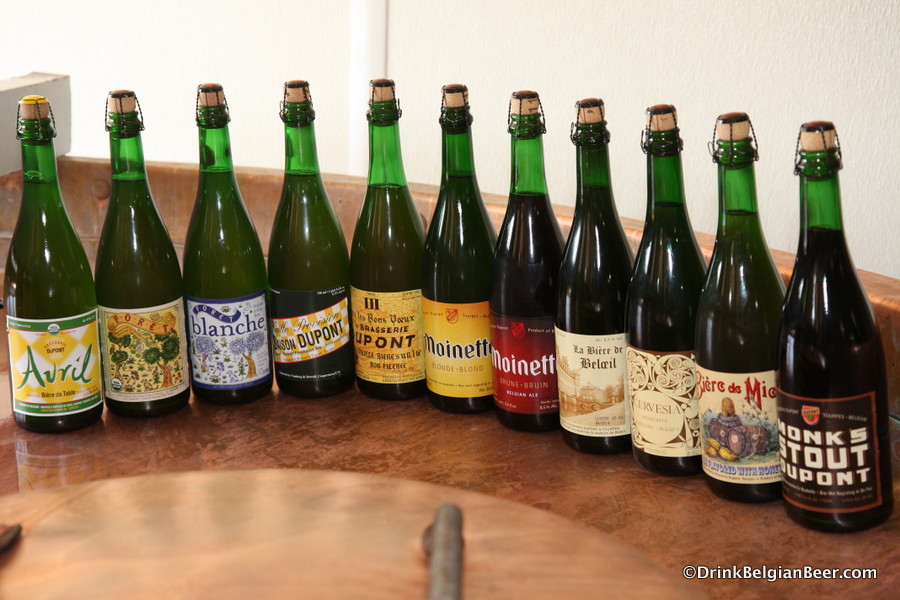During World War II and after, Sylva also worked at a distillery. Clearly, he helped produce a variety of alcoholic beverages!
In 1957, Dupont’s coolship and baudelot were replaced by a plate cooler, which reduced the risk of infection. The first stainless-steel fermenting tanks were installed the same year. When Louis Dupont died in 1964, without any children, Sylva inherited the brewery, along with other relatives. Sylva ran Brasserie Dupont until 1982, when his son Marc Rosier took over. Marc started work at Dupont in 1962. Marc was in charge until he turned over the brewery operations to current Director and Brewmaster, Olivier Dedeycker, in 2002. Olivier is Sylva Rosier’s grandson. He started working at Dupont in 1990. Fifteen others currently work at the brewery as well.

Sylva Rosier was a very prominent person in the Belgian beer world. He and his daughter, Claude, who was also a very accomplished brewing scientist, were both educated at the Katholieke Universiteit of Leuven. They created the ROLA laboratory at Dupont in 1957. The ROLA lab performed brewing and malting analysis, both for Dupont and other breweries in the region. They lab was highly respected for its technical expertise, especially in the area of fermentation. Claude specialized her studies on ales and secondary fermentation in the bottle, something that her classmates in Leuven found amusing, as the trend was to lagers in that time. Perhaps they would see things differently today, given the great success Dupont has had with such beers. The ROLA lab was closed in 2002, when Claude retired.
With Sylva at the helm, Brasserie Dupont produced a number of brews. During his first year in charge, in 1945, he created Redor Pils, which is the only bottom-fermenting beer left in the Dupont lineup today. It also happens to be one of the most flavorful pilsners in Belgium.
Sylva Rosier also brewed a table beer called Familia, with 1.5% abv. Such brews were seen as a good way to teach children about beer, and adults could drink them and feel little effect from the alcohol. Beer was seen as healthier and more fortifying than water in days past, hence the popularity of table beers. A little later, Benelux, a lager with 4% abv, was brewed. Then, Monk’s Stout was first produced in 1950. You’ll read more on that one later in this article.

Photo: Brewmaster/Director Olivier Dedeycker, pouring a Moinette at the copper, direct-fired boiling kettle.
In 1953, Radar ale, a filtered saison, was created. Then, Belge, a top-fermented amber ale, was brewed. It was a “Speciale Belge” which was a style of brew with about 5% abv, similar to Palm and De Koninck.
In 1955, Moinette was created. This 8.5% abv brew is now Wallonia’s benchmark strong golden ale, and has been for a long time.
Moinette brought success to the brewery, and it remains Dupont’s number one seller in Belgium. Primary fermentation runs about one week, with a further two weeks of secondary fermentation using the same yeast strains. (In fact, as many as half a dozen different yeasts may contribute to its lightly spicy, mildly herbal profile.) Moinette is then bottle-conditioned with a different yeast before being placed in a warm room for 6-8 weeks. All this produces a very complex beer.

Moinette Brune was added in 1986. It is a very malty, darkish brown, dry ale with some sweetness and a mild fruitiness. There are four different malts used in its recipe, and it has the same alcohol content as its blond brother. Dupont followed Moinette with Bourgeoise and Etoile, table beers of 2.2 and 3.3% abv, in 1961. In 1963, a sort of barley wine, called Royal Capy, was brewed. I wonder if any bottles of that one are lying around a Belgian cellar somewhere!


Leave a Reply